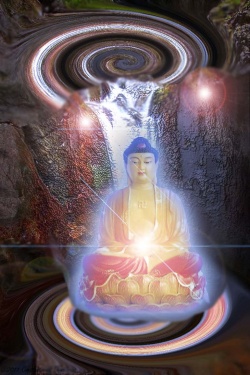The Creation of Time
A Buddhist cosmology?
Everything is spontaneously existing…. (Zen Master Huang Po)
Introduction
On several occasions I have hinted that my ‘ontology’ seems to be compatible with Buddhist conceptions of space, especially with respect to the concept of the space-particle. Here we will see how this Buddhist space-particle is embedded in a complete cosmology, which significantly differs from the Big Bang theory.
First though we have to get a better picture of the fundamental nature of resonance, as it underlies the vibrations of space, the domain of the standing waves, which move, but appear at rest. This paradox of rest and motion is the simplest example of the difference between a field and a wave, which in my view Einstein kept confusing, he made the ‘wave’ into a ‘thing in itself’ (Ding an sich), like the photon, because he had no medium (aether) in his empty space.
So we will have another look at Einstein’s theoretical development and will see that his overall theoretical picture seems to remain ad hoc, confused and contradictory; in a very recent quote we also can find the confusion this has caused in others and at the same time the proof that the relativity of rotation is still advocated by relativists by their concept of ‘Nothingness’, which I will dwell on later (I could not have imagined a better proof of what I claimed in ‘Pendulums and Gyroscopes’ just a couple of weeks ago).
Don’t be mistaken, these are very serious conceptual mistakes, with big adverse consequences.
Permanent creation
To show that there are other than Big Bang cosmologies today, and respectable ones at that, we will encounter the Buddhist version in the words of the Dalai Lama and will see how it fits in many ways and very well with what I propose in these pages.
An important aspect of my analysis is that it seeks to make space understood as a granular fabric of tiny fields sustaining a continuous wave-field of transformation and renewal, a state of, what I call , ‘permanent creation’, (this is not a Buddhist concept, as far as I know).
My approach may be the first scientific ontology conceptually and mathematically consistent with the concept of a space-particle as this is used in Buddhist ontology, although in no way I would want to suggest that my cosmology is a Buddhist interpretation of space or of its space-particles, but it is conceptually sustained by it.
Specifically this model expresses the conditions under which space can condensate and materialize into material reality, in short, how space (energy) transforms into matter (mass), it is rather more of a metamorphosis
The Buddhist space-particle
The Dalai Lama gives the Buddhist alternative to the Big Bang, but also specifies the concept of the ‘space-particle‘ as the enduring substance of the universe, which is all the more remarkable because of the all-pervading concept of ‘impermanence’ in Buddhism.
Dalai Lama: “Buddhist cosmology establishes the cycle of a universe in the following way: first there is a period of formation, then a period where the universe endures, then another during which it is destroyed, followed by a period of void before the formation of a new universe. During this void, the particles of space subsist, and from these particles the new universe will be formed. It is in these particles of space that we find the fundamental con-substantial cause of the entire physical world. If we wish to describe the formation of the universe and the physical bodies of beings, all we need do is analyse and comprehend the way in which the natural potential of different chemical and other elements constituting that universe was able to take shape from these space particles. It is on the basis of the specific potential of those particles that the structure of this universe and of the bodies of the beings present therein have come about.”
This quote sums up what this site is about: replacing the Big Bang theory with a thoroughly different cosmic ontology, which entails finding the potential of the space-particle by means of a thoroughly innovative mathematics of resonance. Well….etc, read the site.
The space-pixall
Space is understood in this cosmology as an aggregate of space-pixalls, called the cosmic deep-field. The pixall itself is a tiny field around a zero-point. The zero-point is a border-point of space, and forms the zero-dimension or ‘Pure Light’. The pixall is reminiscent of the concept of the virtual particle of quantum physics in that the pixall is in a permanent state of spin and transformation, going through all possible shapes it may be called upon to ‘materialize’ into, sheer instantly, it is much like the zero-point energy of the so called ‘physical vacuum’ (a contradictio in terminis, by the way). We see that my model is highly compatible with scientific realities, I only give a twist to the concepts.
geometry of the space-pixall
Our space-pixall is the 3-D, 4-D or 5-D version of the pixel of a screen, but versatile and vibrant, it is more potential than virtual, it is embedded in other pixalls like a bubble in foam, rather fixed, but when excited it forms a plane and an axis, it becomes a gyroscopic entity, an inertia, a toroid geometry, like a magnetic field and it can form axial alignments in field lines as beads on a string, or it can ‘spark’.
An excited space-pixall is part of a temporary local field or interaction and ready to ‘condensate’ into material configurations almost instantly. It forms part of the field lines and is thus the ‘body’ of the geometry of space.
Uniform motion is a form of inertia, it is embedded in the standing wave field of the inertial fields. One might say that the energy a star exudes is part of its inertial field and of its ‘push’, its permanent pressure in the universal deep-field. (Mach would have liked this). This is very visible in the ‘push’ of the Sun in the geometry of the deepfield of the solar system. (see Solar system resonances). (to be published soon)
So we see that the space-pixall is crucial in the push gravity of space because it is the ‘substance’ through which the push is shaped and carried. This is a quantum description of gravity in geometrical terms.
Einstein perfectly describes the field I have in mind by ‘fields of singularities’, only he does not see it as the deep-field (the ether) that I envisage, but this is his vision:
Einstein (1909): “I imagine to myself, each such singular point surrounded by a field that has essentially the same character of a plane wave, and whose amplitude decreases with the distance between the two singular points. If many such singularities are separated by a distance small with respect to the dimensions of the field of one singular point, their fields will be super-imposed and will form in their totality an oscillating field that is only slightly different from the oscillating field of our present electromagnetic theory of light.”
Put for ‘singularity’ the term ‘space-pixall’ and it says what I could not say better, the oscillating field is the ‘deepfield’.
Aether
A good description of the classic ether-concept, abolished by Mach and Einstein, is given by Max Born, it helps to clarify the difference between ‘somethingness’ and ‘nothingness’.
Born (1924): “The undulatory, or wave theory, (..) sets up an analogy between the propagation of light and the motion of waves on the surface of water or sound waves in air. For this purpose it has to assume the existence of an elastic medium that permeates all transparent bodies; this is the ‘luminiferous ether’. The individual particles of this substance merely oscillate about their positions of equilibrium. That which moves on as the light wave is the state of motion of the particles and not the particles themselves.”
This is another perfect description of the deep-field and the space-pixalls as I propose them, only that the pixalls are not really ‘individual particles’, but singular tiny fields (in the Planck length region), like Einstein’s description above. (It must come close to Cartesian vortexes which also Maxwell mentions, even Superstrings sometimes comes near in ‘loops’)
We will therefor go back to a ‘pre-relativity’ Maxwell-Lorentz-type ether, in concept, which is a universal rest frame, contrary to relativity principles, all forms of energy are though in motion relative to the stationary deepfield. No object can be called at rest relative to the deepfield This is one of the main reasons I do have severe doubts about the points of departure of the theory of relativity. It seems to me based on ostensibly logically and empirically untenable postulates (relativity of rotation). When key foundations of a theory are untenable, one wonders what is left to sustain it? Can a final insight ever be right when it is based on the wrong views; it possibly can, but whether in this case, will have our undivided attention here.
“A stubbornly persistent illusion”
I have a book of that title with key texts of Einstein’s, edited by Stephen Hawking, so we must assume this was a serious assertion by Einstein. But what to think of such intimation that “time” is a “stubbornly persistent illusion”, when there is no one like Einstein who has made time so much into a ‘concrete thing’, a ‘Ding an sich’, not to say an ‘idol’, by claiming it bends, curves, slows down, even stands still and it can keep you: forever young, besides being the fourth rock bottom dimension of reality (invoking Newton).
That is quite a ‘persistent illusion’ indeed and it seems then after all not a very solid frame-work or dimension for a scientific picture of the world; at least I cannot take it too seriously with these qualifications by its very creator, because, if it is an illusion, as I agree with Einstein it is, then it should be treated as such.
It is unclear to me why Einstein could not come to see the electromagnetic fields as expressing the fabric, or even part of the geometry of space, whereas he insisted that the speed of the electromagnetic field (light) is the absolute standard of everything moving and even of time, and in fact, in doing so, created the preferential inertial frame which he theoretically denied exists. The constancy of the speed of the electromagnetic field (not light) is the description of the degree of permittivity of a medium, that is: the description of an ether.
Einstein held Maxwell in high esteem and praised the concept of the field proposed by Faraday, but when it came to the electromagnetic field as an expression of the stationary ether Einstein denied the main insight of Maxwell, which was, that the undeniable electro-magnetic wave fields, reaching us from, and stretching into, all corners of the universe, were the sign that there was an ether, that space was full and constantly filled with new energy, with vibration, instead of being vacuous.
The vacuum turned out to be full, it was a plenum. This was groundbreaking news in those days; and still is for many today, 150 years later. Maxwell replaced Newton as the new genius in Physics, but was soon eclipsed by Einstein.
Today we know that Maxwell had the right intuition, space is chock-full of energy, but Einstein made it empty again, then filled it with time, his ‘persistent illusion’.
Luminiferous ether
The wave field as the carrier of light, proposed by Christian Huygens, was proved by Maxwell, which meant a radical break with Newton’s analysis that energy (light) was corpuscular (particles); it was definitely a wave phenomenon according to Maxwell and just appeared as one aspect of an all pervading universal field that functioned as medium, the ‘luminiferous aether’ (light-carrying ether).
As others did, also Maxwell, in the declamation of his major insight, referred to the Creator as the originator of the perceived perfection of Nature.
Maxwell (1861): ” The vast interplanetary and interstellar regions will no longer be regarded as waste places in the universe, which the Creator has not seen fit to fill with the symbols of the manifold order of His kingdom. We shall find them to be already full of this wonderful medium; so full that no human power can remove it from the smallest regions of Space, or produce the slightest flaw in its infinite continuity.”
Empty space
Little could Maxwell expect that what he thought no human power could undo, was conceptually annihilated less than fifty years later by Einstein, declaring there was no ether or any preferential frame of reference in the universe, all was relative, space was empty. He wrote:
Einstein: “The introduction of a “luminiferous aether” will prove to be superfluous inasmuch as the view here to be developed will not require an “‘absolutely stationary space” provided with special properties, nor assign a velocity-vector to a point of the empty space in which electromagnetic processes take place”. (On the electrodynamics of moving bodies, Einstein, 1905) :
This is now an obviously wrong viewpoint, but these statements had then far reaching consequences which he only partly made good by re-instating the ether as indispensable (1920) for general relativity, but the damage was done. The concept of an ‘ether’ never again recovered from the ban put upon it by Einstein, although neither the general theory of relativity nor quantum physics can do without an ether-like medium or ‘fill’ for space to be intelligible, but the word is not used in scientific circles until this day, shunned as an obsolete concept. (they prefer the term ‘nothingness’ now in relativity, I will show)
The Aether again
Einstein in 1920 : “According to the general theory of relativity space without ether is unthinkable; for in such space there not only would be no propagation of light, but also no possibility of existence for standards of space and time (measuring rods and clocks), nor therefore any space-time intervals in the physical sense.”
A volte-face with respect to 1905, in a weak ontological formulation, here definitely asserting an inertial main frame, but still Einstein writes with Infeld in 1938 about ‘a photon traveling through empty space’.
You see it travelling, this photon, over billions of years through empty space, tirelessly ‘waving’ along the geodesics, flawlessly on target. It’s a bit a sorry picture today.
In the same book (Evolution of Physics) Einstein again reneged on the concept of the ether:
‘Looking back at the development of physics, we see that the ether, soon after its birth, became the enfant terrible of the family of physical substances. First, the construction of a simple mechanical picture of the ether proved to be impossible and was discarded. This caused to a great extent the breakdown of the mechanical point of view. Second, we have to give up the hope that through the presence of the ether sea, one co-ordinate system will be distinguished and lead to the recognition of
absolute and not only relative motion. … After such bad experiences, this is the moment to forget the ether completely and to try never to mention its name. We shall say our space has the physical property of transmitting waves and so omit the use of a word we have decided to avoid. The omission of a word from our vocabulary is of course no remedy; the troubles are indeed much too profound to be solved in this way. Let us now write down the facts which have been sufficiently confirmed by experiment without bothering any more about the ‘e—r’ problem.’ – Albert Einstein and Leopold Infeld, Evolution of Physics, 1938, pp. 184-5
Seventy years on nobody mentions the ‘ether’ anymore, but the problems have not gone away, probably because the concept of a medium was abolished. It triggered a spate of absurd concepts of which ‘nothingness’ is the crowning jewel.
Here then a quote from a very recent article in a Dutch quality paper (Vk 26/3/11) commemorating the 150 birthday of Maxwell’s equations (it’s Maxwell year!) spoken by a Dutch scientist (prof. Gerard Nienhuis).
“The crucial thing about Einstein is that he reasons that the medium is nothingness itself, the empty space. When you let nothingness flow by moving, nothing changes, that is in one sentence the theory of relativity”.
I think this will make Heidegger turn in his grave to listen and say : “Ich hab’s immer gesagt: “das Nichts nichtet”. (= “Nothingness nothings”, no joke)
This is serious scientific nonsense and it shows moreover a persisting belief in the ‘relativity of rotation’ like ‘nothing’ else and that is another serious fallacy. This is how far it has gone when it comes to explaining relativity, the pillar of modern theoretical physics; ‘relativity’ has created a conceptual quagmire, treating concepts of
negation as physical realities, as solid ground, this is the more remarkable after a century of ‘language philosophy’ and ‘screening of scientific language'; it seems to have been to no avail…. we are back at square one in science…….. the medium is nothingness itself,…….. you let nothingness flow by moving…., nothing changes..’ (You let ‘nothingness’ rotate by rotating’, could be the next one; it is the end of scientific discourse)
We see here that ‘Nothingness’ has become the central concept of relativity theory and this disqualifies the theory as a physical theory, it has become metaphysics ( according to Mach’s positivist principles; he did not like relativity theory, thought it too rigid, too ‘aether’, maybe). There is no place for ‘nothingness’ in quantum physics.
I did not know it was this bad conceptually with scientists, but it also makes it quite sure that I am right as regards the missing ‘dark matter’ problem due to overlooking rotational inertia. You need only one authoritative scientist talking obvious nonsense, to expose the state of confusion in theoretical physics today. What one calls empty the other one calls full. A century of critical language philosophy down the drain; I think that is pretty serious.
The past cannot be changed
Since scientists miss 90 percent of the energy (mass) of the universe, this means in fact missing 90 percent of the inertia and this means not understanding what is going on. Since I have shown that the big picture of inertia is a standing wave-field of resonance, we can conclude that the scientific approach to ‘gravity’ completely misses the point, the whole concept is wrong, since it overlooks rotation, the key to inertia and the toroidal geometry of space.
Rotation is possibly a better candidate for the 4th dimension of space and when we add another perpendicular rotation as the 5th dimension, then we have a torus and probably all we need to describe the geometry of space and of the space-pixall.
The big picture of the universe is just this overwhelming immobility, what once was called ‘the fixed stars’, the firmament. It is a cumulative inertia of ever greater cosmic structures frozen in space, which creates the ever deeper gravity wells that telescopes probe. The missing inertia (dark matter) has been visible for years in the redshifts.
In general the more energy (mass) involved in a system the deeper the dominance of its inertial field. The moon follows the earth, the earth, the sun, the solar system, the local area, then the Milky Way, the Local Group and so on, with ever bigger scales, ever slower cycles, ever greater time-spans, ever greater inertia. Whatever the scale, the energy fields are with us now, their sources may even be gone, but their presence, the stability of their fields, is here with us now, this is how the past pervades the present through the energy of space and why time does not exist.
What is gone cannot be changed, but cannot be taken away either. What we see around us is here from an unfathomable deep past. The unchangeable past gives the present its stability and its future, it does not move. The inertia of the past is the rest of the present. The past cannot be taken away because everything springs from it constantly. This is why the truth will always surface and information does not get lost, as it becomes the base of the future.
It may be seen as close to the law of Karma of Eastern philosophy.
Gravity well and Red shift
What we can conclude from this is that the further away and farther back, we go, the stronger the accumulated inertial fields, but this is just relative to our position. So the further away the stars or galaxies the more inertial field, or spatial curvature, there is in between us, which determines the amount of redshift. The deeper space is probed, the deeper the ‘gravity well’ that comes with it and the more the wave-field will be stretched into the red, will be red-shifted. The ‘gravity-well’ is the clearest and simplest explanation for the cosmic redshift because light undergoes a gravitational redshift when coming forward from a relatively stronger gravity field, ‘climbing up the gravity-well’, as it is called.
We see here how this interpretation of the redshift, which is simpler and providing a more straightforward insight (Occam’s razor), how this interpretation completely undermines the most solid pillar of the Big Bang cosmology, the redshift as evidence of the receding light sources (stars), which would point at the expansion of the universe.
This conclusion generated the ‘logic’ that this expansion must have had a beginning, so that it can be traced and contracted back in time until we arrive at a singularity, a point without dimension. That is where everything is coming from, the primordial bang of that original singularity, that point without dimension.(Can you imagine?).
Isn’t that indeed an awesome straight logic, very, very clever!
Anyhow we had found the answer, because we had found the beginning of everything, now we had our own solid scientific story of creation. Mind you, scientific, no vague religious nonsense; and with a true identifiable beginning……, at last: the BANG, about 14 billion years ago.
How we crave for beginnings and ends. There must be a beginning of the universe we feel, but now that we have got it, like children, we ask: and what was there before the Bang?
Exasperated our cosmologists tell us: “There was no time before the Bang, so there was no ‘before’….., stupid.”
These guys have all the answers!
But it doesn’t add up. The redshift is no argument for dynamic space expansion, but possibly a very good argument (and measure, maybe) for all the inertia and ‘curvature’ science is still missing, the ‘Dark matter’.
The question of Dark matter is that of ‘the missing mass’, but in fact it is the ‘unexplained inertia’ of all the individual stars, of their systems and of other objects that act as inertial gyroscopes. These rotating bodies are sustained by, but at the same time, sustain, the cosmic inertial deep-field, because they, with their inertial reflection fields, so to speak, add their ‘rest-momentum’ to the stability of the whole. By being in perpetual uniform motion the body with its reflection field ‘con-firms’ the stability of the deep-field and in that sense is conform Mach’s principle as conceived by Einstein. The reflection field expresses the presence of the body in the deep field, which is accordingly ‘curved’ in its geometry by the body and the reflection.
This is how nature seems to work: every transformation of energy feeds back into and sustains the whole. (like conservation of energy)
Inertia vs gravity
The inertial stability of the solar system is rooted outside the system, the stability of all cosmic systems, is rooted in the individual inertial fields of the components in the deep-field of inertial space. If there were no preferential inertial rest frame how could there be uniform motion or parallel motion, like waves? It is the medium that conditions the transfer/movement of energy.
It is the absolute spinning movement (the gyroscope again), relative to the whole which creates the inertial field of the object with its deep-field geometry, whether it be an electron or a star. The stability of the solar system is rooted in the inertial stability of each of its constituent bodies with respect to the whole universe. It is this basic individual stability with respect to the whole, which makes orderly interaction between bodies in a system possible.
Even a galaxy is a rotating inertial system, of which we can only discern the internal stress by the ‘torsion’ of its appearance as you have seen in all those magnificent pictures of spiral galaxies in outer space, that is the frozen relativity of time. There is no chaos there and nobody doubts there is rotation and a vortex (black hole) involved, but the problem of dark matter is the different time scales and, of course, that is: the relative inertia.
A Buddhist cosmology?
So far I have put forward a Buddhist and a Buddhist-inspired alternative to the Big Bang cosmology and suddenly you have a choice where you may have thought there was no choice, the choice between the BigBang cosmology of Big Science and the cyclic Buddhist universe, or some unfinished emerging cosmology like mine.
The Buddhist cosmology of four stages mentioned earlier does not really reflect the attitude of the Buddha himself towards cosmological questions, but is a doctrinal development picture in the spirit of the four-fold truth of suffering.
In general the Buddha actually refused to answer questions about ‘how the world originated’ and other metaphysics, he even compared such questioner in a famous parable to: a man wounded by an arrow who first wants to know who shot the arrow and why, before removing it; he would die before he had the answers.
We all carry the arrow of death. We are urged to act here and now so we can remove the arrow and live beyond death. That seems the mystic message of the Buddha’s personal cosmology.














